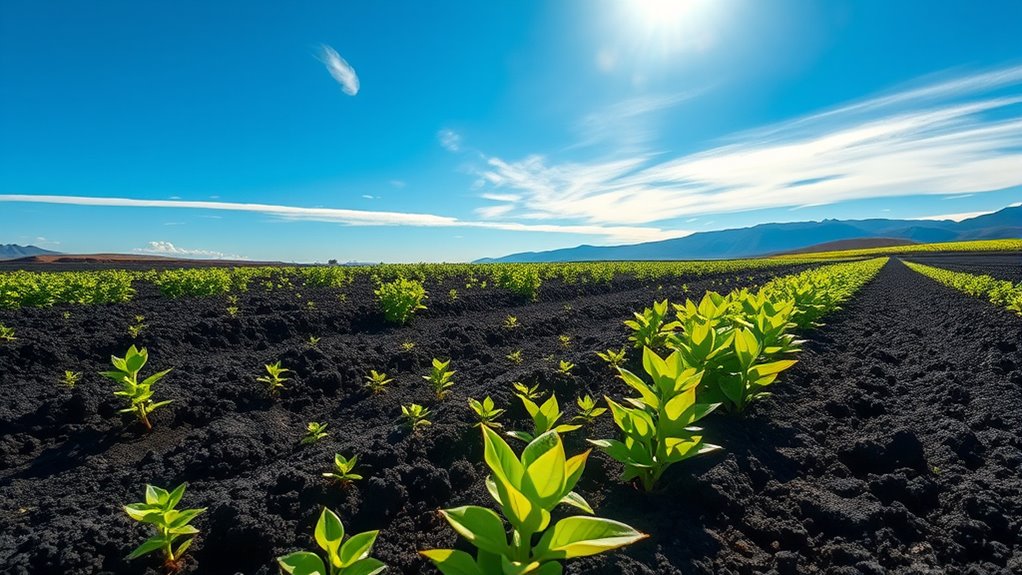To grow healthy chia plants, make certain you use well-draining loamy soil with a pH between 6.0 and 7.0, enriched with organic matter like compost. The climate should be warm and sunny, with at least six hours of direct sunlight daily and temperatures between 65°F and 85°F. Avoid frost and overly wet conditions, as they can harm your crops. Keep exploring for more tips to optimize your chia growing success.
Key Takeaways
- Use well-draining loamy soil with a pH of 6.0 to 7.0, enriched with organic matter like compost.
- Plant in warm, sunny environments with temperatures between 65°F and 85°F (18°C to 29°C).
- Ensure at least 6 hours of direct sunlight daily for optimal seed production and growth.
- Avoid heavy clay or overly sandy soils; maintain proper soil structure for root health.
- Grow in areas with good air circulation, avoiding frost and extreme weather for best results.

Chia plants thrive best in well-draining soils with a balanced mix of nutrients, and understanding the right climate is vital for healthy growth. When you’re preparing to cultivate chia, pay close attention to the soil composition. These plants prefer soil that isn’t too compacted or waterlogged, so incorporating organic matter like compost can improve drainage and provide essential nutrients. Loamy soils with a slightly acidic to neutral pH, around 6.0 to 7.0, are ideal because they hold enough moisture while allowing excess water to flow away, preventing root rot. Avoid heavy clay soils or overly sandy terrains, as they can hinder proper nutrient uptake and water retention. Testing your soil’s pH and drainage capacity before planting helps guarantee you create the best environment for chia’s development.
Understanding climate adaptability is equally important. Chia plants are quite versatile, but they prefer warm, sunny conditions with moderate humidity. They thrive in temperatures between 65°F and 85°F (18°C to 29°C), so if you live in a cooler climate, consider starting seeds indoors or using season extension techniques. These plants are sensitive to frost, so planting after the last frost date is vital. They require full sun—at least six hours of direct sunlight daily—to produce high-quality seeds and healthy foliage. While chia can tolerate some drought once established, consistent watering during germination and early growth stages promotes robust root development. Ensure your climate provides a stable environment with minimal extreme temperature fluctuations, as sudden cold snaps or heatwaves can stress the plants and reduce yields.
Additionally, climate adaptability influences pest and disease resistance. In areas with high humidity and poor air circulation, you might encounter fungal issues or pests like aphids. To mitigate this, plant in well-ventilated areas and avoid overcrowding. If you’re growing in a region with unpredictable weather patterns, consider raised beds or containers that offer better control over soil and microclimate conditions. This flexibility allows you to adjust watering schedules, shade during excessive heat, or protect against unexpected cold snaps.
Frequently Asked Questions
How Often Should I Water Chia Plants During Dry Seasons?
During dry seasons, you should water your chia plants regularly, aiming for a consistent watering frequency that keeps the soil moist but not waterlogged. Chia plants have some drought tolerance, but they thrive with steady moisture. Check the soil daily and water when the top inch feels dry. This approach helps maintain healthy growth and prevents stress, ensuring your plants stay resilient even in hot, dry conditions.
Can Chia Plants Grow Successfully Indoors?
Imagine nurturing a tiny green marvel indoors, where your care turns a small seed into a lush plant. You can grow chia successfully inside by providing ample indoor lighting, like a sunny windowsill or grow lights. Choose a well-draining container to prevent overwatering. With consistent moisture and the right environment, your chia plant will thrive indoors, rewarding you with vibrant greens no matter the season.
What Are Common Pests That Affect Chia Plants?
You should monitor your chia plants for common pests like aphids, spider mites, and whiteflies, which can hinder growth. Regular pest management involves inspecting leaves and stems, using natural predators or gentle insecticidal soap. Keep an eye out for plant diseases such as mold or root rot, which thrive in overly damp conditions. Address pests early to prevent damage and make certain your chia plants stay healthy and productive.
How Long Does It Take for Chia Seeds to Mature?
Did you know that chia seeds typically take about 7 to 14 days for seed germination? Once your plants start to grow, you’ll see plant maturity around 3 to 4 months after planting. Factors like temperature and watering influence this timeline, but generally, patience pays off. Keep an eye on your chia plants as they develop, and you’ll soon enjoy the fruits of your labor when they reach full maturity.
Are There Specific Fertilizers Recommended for Chia Cultivation?
You should use organic nutrients to fertilize your chia plants, as they thrive with natural inputs. Stick to a consistent fertilization schedule, applying organic compost or composted manure every few weeks during the growing season. Avoid synthetic fertilizers, which can harm the plants or reduce seed quality. Regular organic fertilization ensures your chia plants get essential nutrients for healthy growth and ideal seed production.
Conclusion
If you’re wondering whether chia plants really need perfect soil and climate, the truth is they’re surprisingly adaptable. While they thrive in well-drained, nutrient-rich soils and warm, sunny conditions, some growers have successfully cultivated them in less-than-ideal environments. This suggests that, with a bit of effort, you can experiment beyond traditional guidelines. So, don’t hesitate to try growing chia—you might just discover a new secret to their resilience and success!









